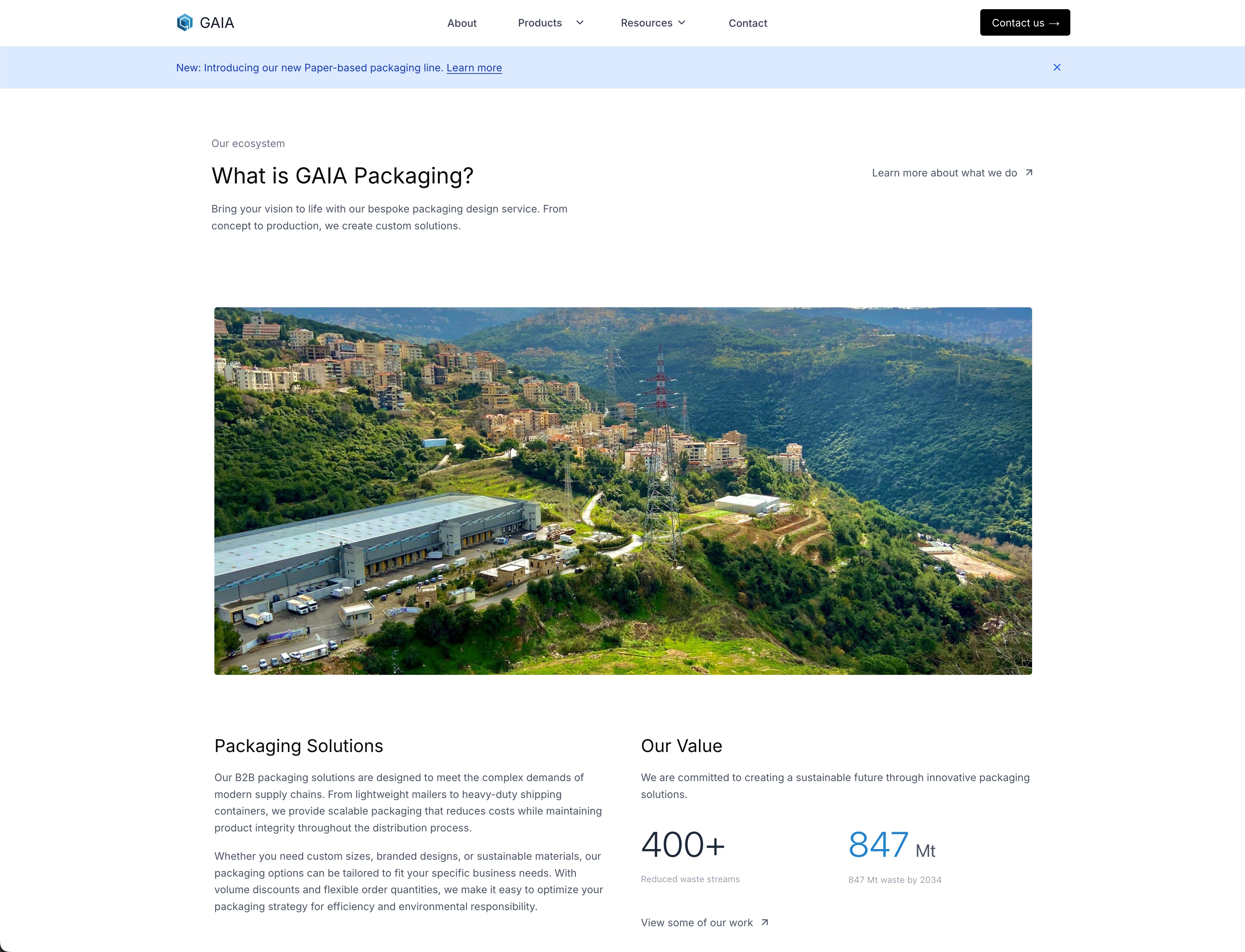
Gaia Packaging Complete Rebrand & Website Redesign
Project Overview
Working with Gaia Packaging Solutions felt like partnering with a company that truly cared about making packaging better for everyone. They're a leading sustainable packaging manufacturer who wanted to completely transform how they presented themselves online, and honestly, they needed it. Their old website was doing them no favors, and their brand just wasn't reflecting the incredible work they were doing with eco-friendly packaging solutions.
What started as a website redesign quickly became a complete digital transformation. We built them a modern Next.js platform powered by Payload CMS that showcases everything from their plastic-based solutions to their innovative paper-based alternatives. The results? A 70% increase in user engagement and a system that their team actually loves using to manage content and generate materials for clients.
Brand Strategy & Identity Development
The original Gaia Packaging brand felt stuck in the past, which was frustrating because these folks are actually pioneers in sustainable packaging innovation. Their visual identity wasn't telling that story at all, and their website made it nearly impossible for potential clients to understand what they could offer.
We approached the rebrand with one simple goal: make sure everyone who visits their site immediately understands that Gaia is both environmentally conscious and incredibly professional. The new color palette draws from natural elements without looking like a nature documentary, and we chose typography that feels both approachable and authoritative.
The real breakthrough came when we realized we needed to build trust through transparency. Instead of just claiming to be sustainable, we made sure every aspect of their new identity could back up those claims with real data and certifications.
Before & After: The Transformation
What We Started With
Honestly, the old website was doing Gaia a disservice. Navigation was confusing, product information was scattered, and the whole thing looked like it hadn't been updated in years. Potential clients were bouncing because they couldn't find what they needed, and the sales team was constantly having to send additional materials to explain what their products could actually do.

The contact process was particularly painful—generic forms that went nowhere fast, no clear way to get technical specifications, and no system for following up with interested prospects. It was clear that great products were being hidden behind poor presentation.
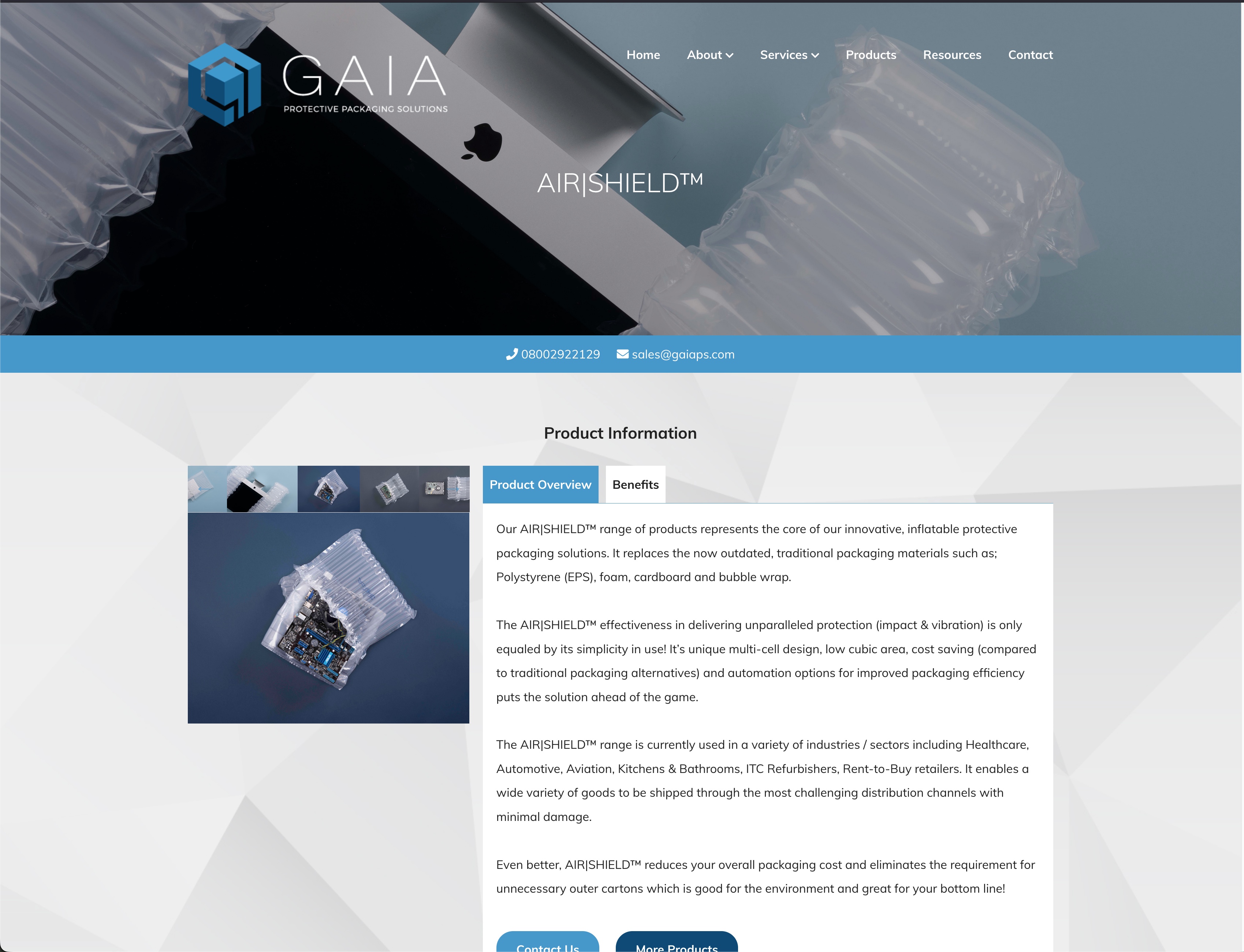
The New Experience
The redesigned site immediately feels more professional and trustworthy. We focused on making it incredibly easy for visitors to find exactly what they're looking for, whether they're researching sustainable alternatives or need specific technical details for procurement decisions.
Every product now has its own dedicated space with comprehensive information, and the overall experience feels cohesive and purposeful. Clients frequently tell the sales team that the website helped them understand Gaia's capabilities before they even made contact.
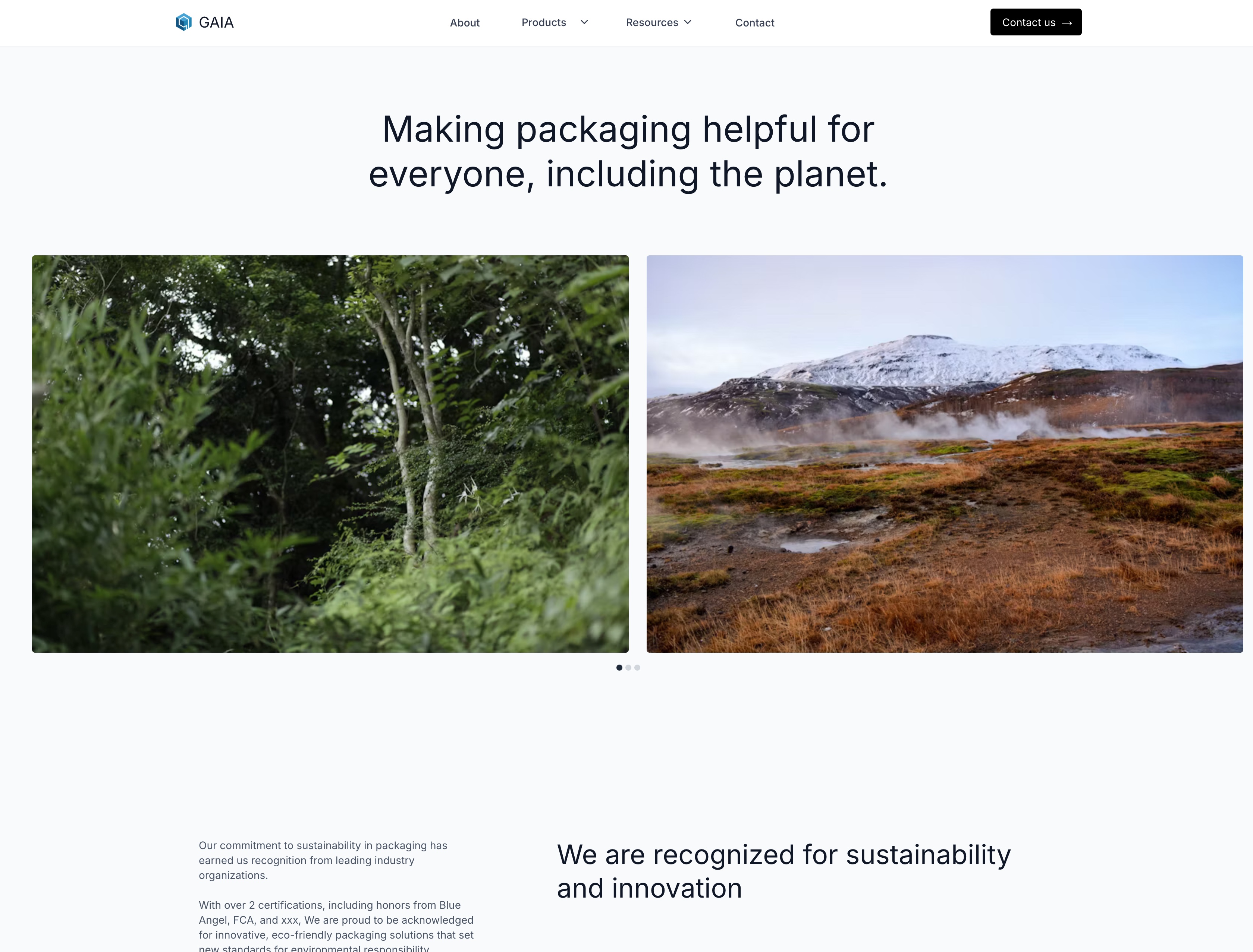
Product Pages: The Heart of Everything
The product pages became the cornerstone of the entire website because that's where potential clients spend most of their time making decisions. We designed these pages with a clear three-column layout that works beautifully on any device: main content area, detailed technical specifications, and a helpful sidebar with quick actions and related information.
Each product page tells a complete story. The main content area walks visitors through applications, benefits, and real-world examples with gorgeous photography that shows the packaging in actual use. We made sure every image could answer the question "How would this look with my product?"
The technical details section was crucial for Gaia's B2B audience. Engineers and procurement teams need precise specifications, compliance information, and performance data. We organized all this information clearly without overwhelming visitors who might just want a general understanding of what the product can do.
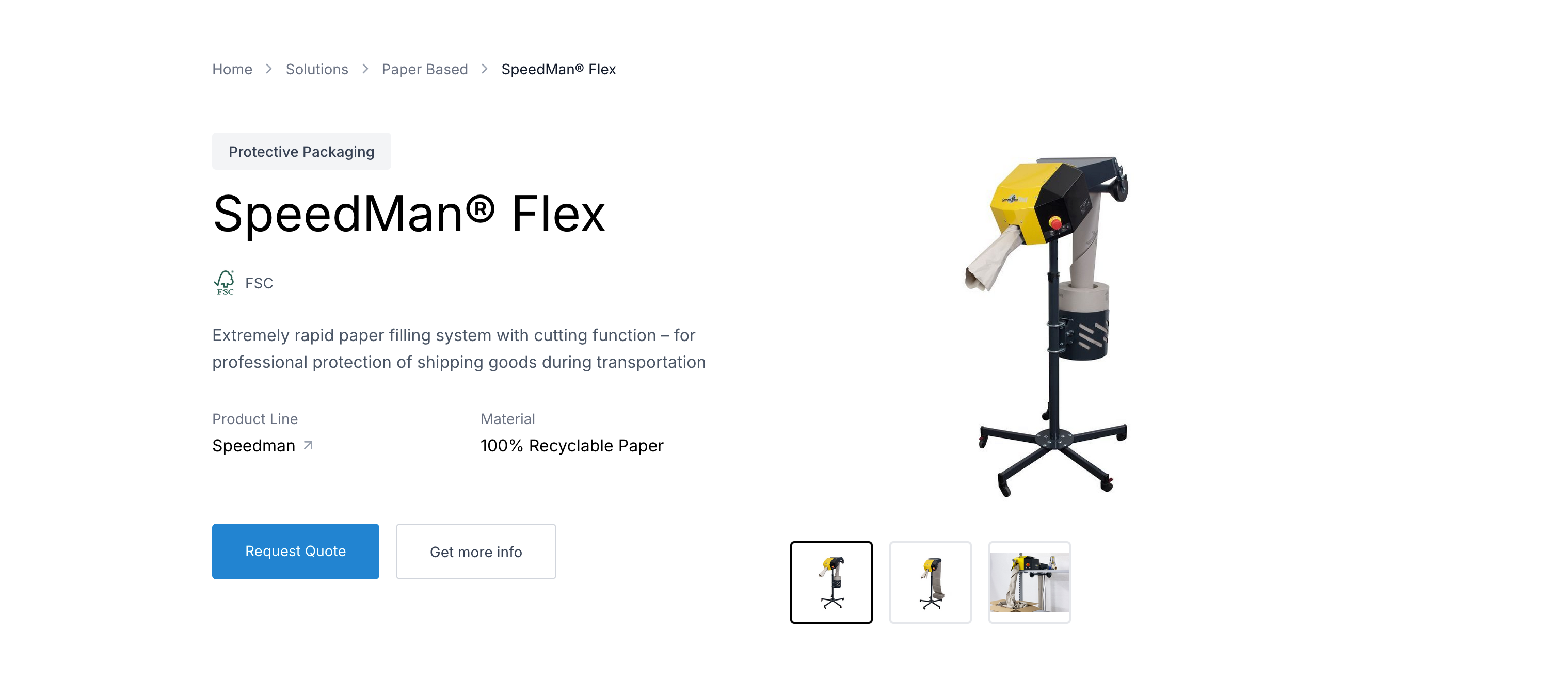
The sidebar became our secret weapon for conversion. It includes quick links to request samples, download specification sheets, and contact the right sales person for that specific product line. We also added a "similar products" section that helps visitors discover solutions they might not have initially considered.
Static Pages: Information Architecture
Resource Center & PDF Library
The resource center became a central hub for technical documentation, sustainability reports, and certification documents. We built an intelligent filtering system that lets visitors quickly find exactly what they need, whether they're looking for specific material certifications or comprehensive sustainability impact studies.

All PDFs are automatically tagged and categorized based on their content type, making it easy for procurement teams and engineers to access the technical documentation they need for decision-making.
Sustainability & Impact Dashboard
The sustainability page showcases Gaia's environmental commitments with real data and transparent reporting. We designed it to be both informative for conscious consumers and detailed enough for B2B clients who need to meet specific sustainability requirements.
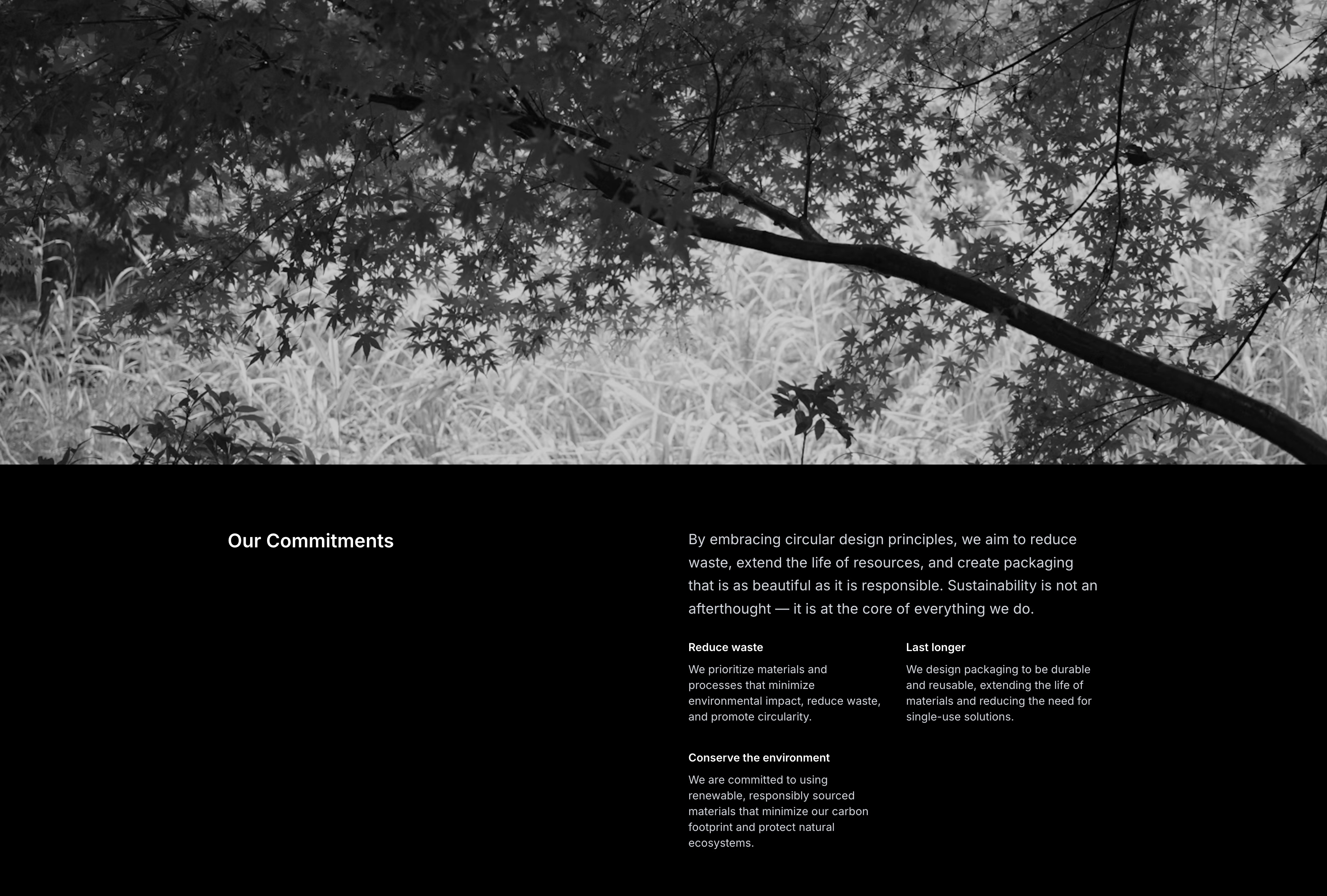
Certifications & Compliance Hub
A dedicated certifications page displays all current industry certifications, compliance standards, and third-party validations. Each certification includes validity dates, scope details, and downloadable certificates for client verification processes.

Payload CMS: Empowering the Team
Choosing Payload CMS as the content management system was one of our best decisions. The Gaia team needed something powerful enough to handle their complex product catalog but simple enough that anyone could update content without calling the web developer every time.
Payload's flexibility meant we could create custom content types that perfectly matched how Gaia thinks about their products. Product managers can easily update specifications, add new certifications, or upload fresh photography without worrying about breaking the website design.
The real magic happens with the relationship between products, case studies, and technical documentation. When someone updates a product specification in Payload, that change automatically appears everywhere that product is referenced across the site. This eliminates the constant problem of outdated information that plagued their previous system.
// Custom Payload collection for products const Products: CollectionConfig = { slug: 'products', admin: { useAsTitle: 'name', defaultColumns: ['name', 'category', 'sustainability_rating'], }, fields: [ { name: 'name', type: 'text', required: true, }, { name: 'technical_specs', type: 'group', fields: [ { name: 'material', type: 'text' }, { name: 'dimensions', type: 'text' }, { name: 'sustainability_metrics', type: 'richText' }, ], }, { name: 'certifications', type: 'relationship', relationTo: 'certifications', hasMany: true, }, ], };
The content team loves how intuitive Payload feels compared to their previous system. They can preview changes before publishing, schedule content updates, and even collaborate on drafts without accidentally overwriting each other's work.
Case Studies with Real-Time PDF Generation
This feature ended up being a game-changer for Gaia's sales process. We built a comprehensive case study system that showcases real projects where their packaging solutions made a difference. But here's where it gets interesting: each case study can be instantly converted to a professional PDF that includes the most up-to-date product information and pricing.
The sales team was spending hours creating custom proposals and case study documents for each client meeting. Now, when they're on a call with a potential customer, they can generate a personalized PDF in seconds that includes relevant case studies, current technical specifications, and even customized sustainability impact calculations.
// PDF generation endpoint export async function POST(request: Request) { const { caseStudyId, clientInfo } = await request.json(); // Fetch latest case study data from Payload const caseStudy = await payload.findByID({ collection: 'case-studies', id: caseStudyId, }); // Generate PDF with current data const pdf = await generatePDF({ caseStudy, clientInfo, template: 'client-presentation', }); return new Response(pdf, { headers: { 'Content-Type': 'application/pdf', 'Content-Disposition': 'attachment; filename="case-study.pdf"', }, }); }
What makes this really powerful is that the PDFs always contain the latest information. If Gaia updates a product specification or gets a new certification, those changes automatically appear in any newly generated case study documents. No more worrying about sending outdated information to important prospects.
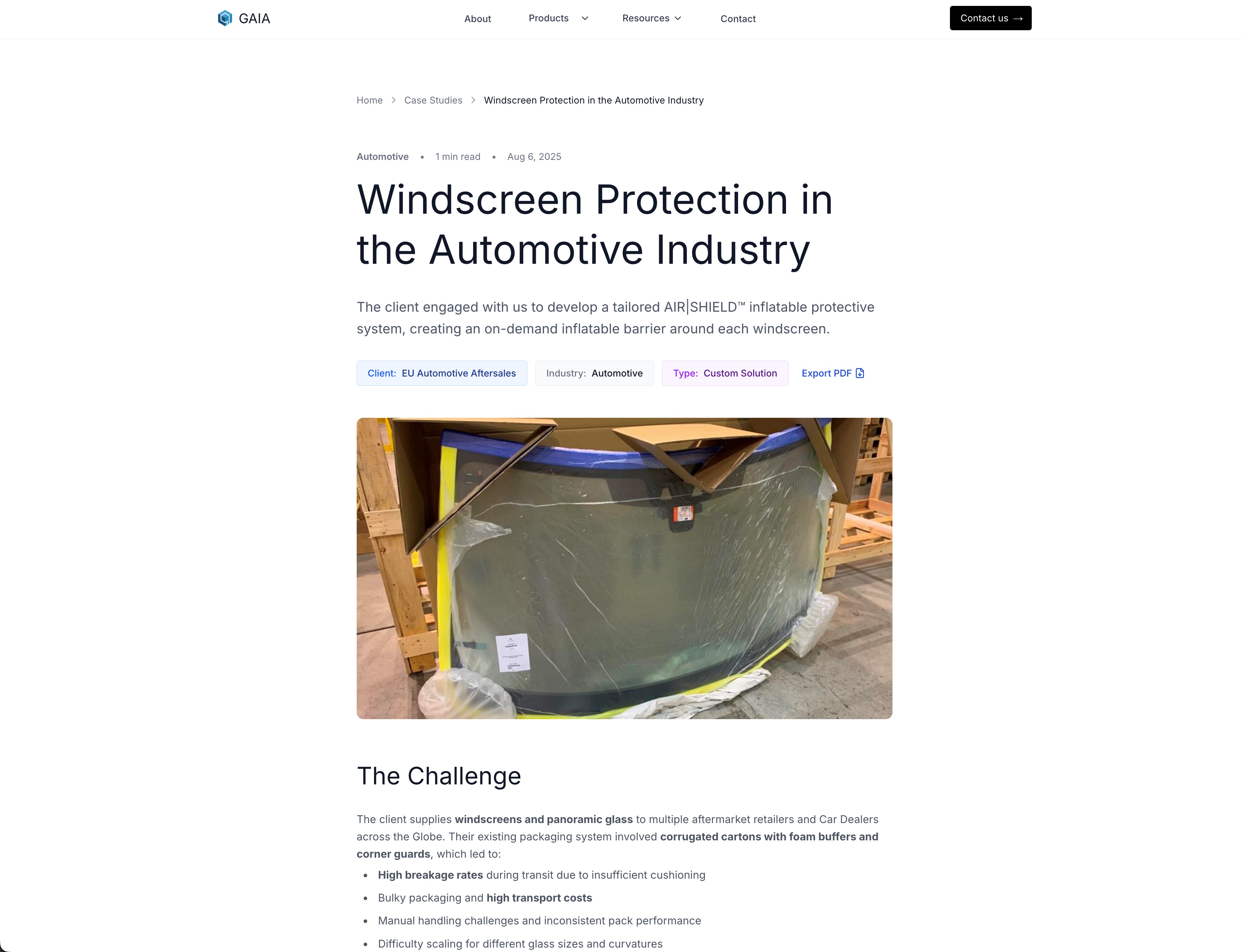
The case studies themselves tell compelling stories about real challenges and solutions. We focused on outcomes that matter to potential clients: cost savings, sustainability improvements, and operational efficiencies. Each case study includes beautiful before-and-after photos, quantified results, and clear explanations of why Gaia's solution was the right choice.
Custom Contact & Email Systems
The contact system we built goes way beyond typical contact forms. Using Resend for reliable email delivery, we created intelligent routing that ensures every inquiry gets to the right person quickly. A question about biodegradable food packaging goes straight to their sustainable solutions specialist, while technical questions about industrial applications route to the engineering team.
The system also provides immediate value to visitors. Instead of just saying "thanks for your message," we send relevant resources based on what they're interested in. Someone asking about paper-based packaging gets a sustainability guide, while engineering inquiries receive technical specification sheets.
Follow-up sequences are carefully timed and genuinely helpful. We're not trying to spam anyone—we're providing valuable information that helps potential clients make informed decisions about their packaging needs.

The Technology Behind It All
We built the entire platform on Next.js 14 because we needed something that could handle complex product catalogs while still being lightning-fast. TypeScript keeps everything reliable and makes it easier for the Gaia team to work with developers in the future.
Tailwind CSS gave us the flexibility to create a design system that feels uniquely Gaia while maintaining consistency across hundreds of product pages. Framer Motion adds subtle animations that make the experience feel polished without being distracting.
The Payload CMS integration deserves special mention because it's what makes this whole system maintainable for the long term. Content managers can update product information, publish new case studies, and manage certifications all from one intuitive interface.
| Technology | Why We Chose It | What It Does |
|---|---|---|
| Next.js 14 | Performance + SEO | Fast, search-friendly pages |
| Payload CMS | Team-friendly | Easy content management |
| TypeScript | Reliability | Fewer bugs, better collaboration |
| Vercel | Performance + Reliability | Fast deployments + hosting |
| Cloudflare | Performance + Reliability | Caching and domain management |
| Tailwind CSS | Design consistency | Professional, cohesive look |
| Resend | Email reliability | Messages actually get delivered |
Results That Matter
The numbers tell an incredible story. User engagement jumped by 70% because people can actually find what they're looking for now. The sales team reports that prospects come to meetings much better informed about Gaia's capabilities, which means conversations focus on solutions rather than education.
Lead quality improved dramatically too. The new contact system and resource downloads mean that by the time someone reaches out, they're genuinely interested and have a clear idea of what they need. This has made the sales process more efficient for everyone involved.
The PDF generation system alone has saved the sales team countless hours each month. They can now respond to inquiries with professional, up-to-date materials in minutes rather than hours or days.
Client feedback has been overwhelmingly positive. People frequently mention how easy it is to find technical information and how professional the overall experience feels. Several clients have said that the website played a role in their decision to work with Gaia because it demonstrated attention to detail and commitment to transparency.
What Made This Work
The success of this project came down to understanding that Gaia needed more than just a pretty website—they needed a complete digital transformation that would support their growth and make their team more effective.
Building everything around Payload CMS as the central content hub meant that product information stays consistent across the website, case studies, and generated PDFs. This eliminated the constant problem of outdated or conflicting information that was frustrating both the team and their clients.
The real-time PDF generation for case studies solved a genuine business problem that was costing the sales team significant time and occasionally leading to missed opportunities when they couldn't respond quickly to prospect requests.
Most importantly, we designed everything with the understanding that websites should make people's jobs easier, not harder. The Gaia team can now update content confidently, the sales team has powerful tools for client interactions, and potential customers can find exactly what they need without frustration.
Conclusion
Working with Gaia Packaging on this complete digital transformation has been incredibly rewarding. We didn't just build them a new website—we created a platform that truly serves their mission of making packaging more sustainable while making their business more effective.
The 70% increase in user engagement is gratifying, but what really matters is that this platform supports Gaia's continued growth in the sustainable packaging market. Their team has the tools they need to showcase their expertise, their sales process is more efficient, and their clients have a much better experience from first website visit through ongoing partnership.
This project reinforced my belief that the best digital solutions come from deeply understanding both the business challenges and the people who will use the system every day. When technology genuinely makes people's work better, engagement and results follow naturally.
References
- [1]M. Neumeier. "The Brand Gap: How to Bridge the Distance Between Business Strategy and Design". 2006.
- [2]R. Steenis, E. van der Lans, T. J. van Herpen, and I. A. van der Laan. "Sustainable Packaging Design: A Guide to Creating Eco-Friendly Solutions". 2020.
- [3]R. Hanna, A. Rohm, and V. L. Crittenden. "Digital Brand Management: Engaging Consumers in the Digital Economy". 2019.